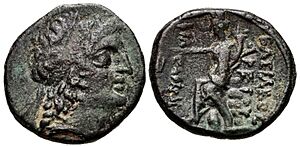Aretas III facts for kids
Aretas III was a powerful king of the Nabataean kingdom. He ruled from 87 to 62 BCE (Before Common Era). Aretas became king after his brother, Obodas I, passed away in 87 BCE. During his time as king, he made his kingdom much larger. It grew to cover parts of what are now northern Jordan, southern Syria, and some of Saudi Arabia.
Aretas's greatest achievement was probably taking over the city of Damascus. This made his country a very important power in the region. The Nabataean kingdom was at its biggest under Aretas's rule.
Taking Over Damascus
Damascus was a key city because it was on the main trade route from the Mediterranean Sea to India and the Middle East. Aretas took the city from the Seleucid Empire in 85 BCE. The Seleucid Empire was a large kingdom that was losing its power.
Aretas called himself Aretas Philhellen, which means "friend of the Greeks". He ordered the coin-making factories in Damascus to create the first silver Nabataean coins. These coins looked Greek and had his name written in the Greek language, not in the Nabataean language.
To make the Nabataeans more like the Greeks, Aretas brought Greek and Roman building styles to Petra, the Nabataean capital. He also built new settlements like Humayma. One big project was a 26.8 km (about 16.6 miles) aqueduct, which is a channel to carry water.
Nabataean rule over Damascus was stopped in 72 BCE. The Armenian king Tigranes II successfully attacked the city. But Armenian rule ended in 69 BCE when Tigranes's forces left to fight the Romans. This allowed Aretas to take Damascus back.
Helping Hyrcanus in Judea
In 67 BCE, Hyrcanus II became the king of Judea. Just three months later, his younger brother Aristobulus II started a rebellion. Aristobulus successfully overthrew Hyrcanus and took both the titles of King and High Priest.
Hyrcanus was kept in Jerusalem, where he still received money from his High Priest role. However, he feared for his life. So, he escaped to Petra and made a deal with Aretas. Aretas agreed to help Hyrcanus. In return, Hyrcanus's main advisor, Antipater the Idumaean, promised that the Arabian towns taken by the Hasmoneans would be returned to Nabataea.
Aretas marched towards Jerusalem with 50,000 men. He surrounded the city for several months. Eventually, Aristobulus offered money to Marcus Aemilius Scaurus. Scaurus was a Roman leader working for the general Pompey.
Dealing with the Romans
Scaurus ordered Aretas to pull his army back. On their way back to Nabataea, Aretas's army suffered a big defeat from Aristobulus's forces.
Even though Aretas obeyed, Scaurus marched on Petra in 62 BCE. But the difficult land and low supplies forced Scaurus to ask for help from Hyrcanus. Hyrcanus was now the High Priest of Judea. He sent Antipater to make a peace deal with Aretas. The siege was lifted in exchange for hundreds of talents of silver (a large amount of money) for Scaurus. Aretas also had to accept that Rome was more powerful than Nabataea.
Aretas was allowed to keep all Nabataean land and possessions. He became a vassal (a ruler who owes loyalty to a more powerful one) of the Roman Republic.
The famous Al-Khazneh building, also known as 'The Treasury', in Petra is believed to be where Aretas III was buried.
See also
- List of rulers of Nabatea


